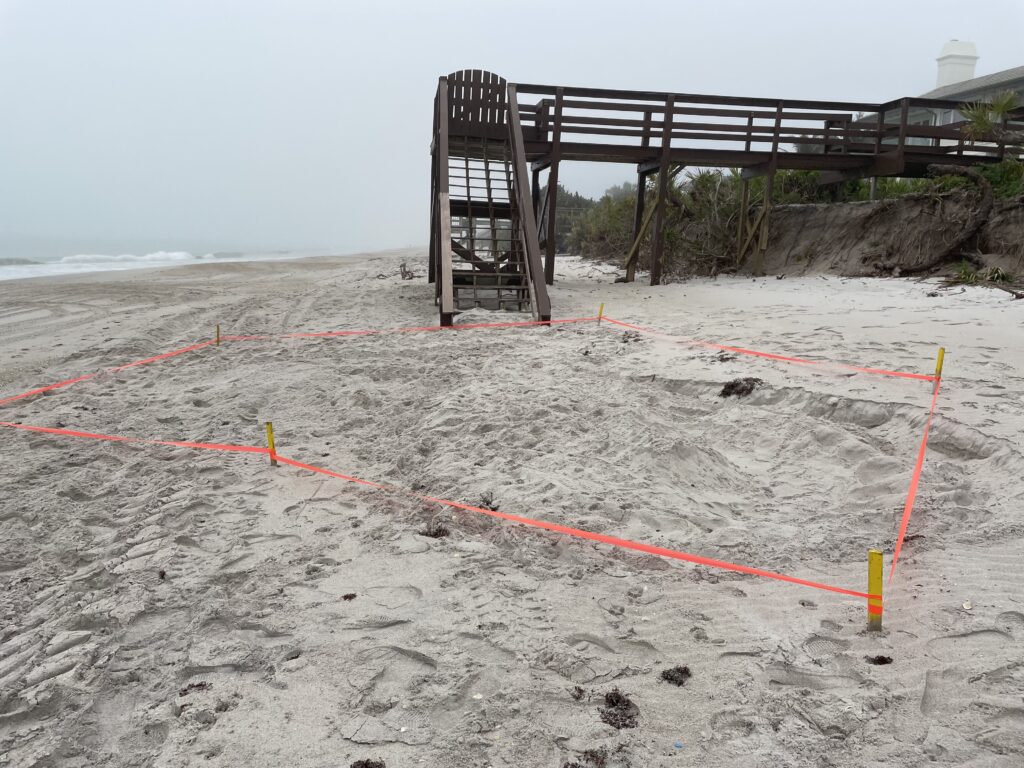INDIAN RIVER COUNTY — Spring breakers may be heading to the beaches for some rest and relaxation, but county officials are reminding beachgoers to stay alert for sea turtle nests in the sand. County workers continue to educate the public on the endangered and threatened sea turtle species – loggerheads, greens and leatherbacks – as nesting season began earlier this month.
The lumbering giants are known to sometimes wade in from the ocean to burrow part way into the sand and lay eggs along Florida’s shoreline – including Indian River County.
“A subsample of nests are marked throughout the county. On some highly active beaches, higher percentages of nests are marked to prevent damage from umbrellas and digging,” Indian River County public works officials said in a statement. “To protect nests, only dig or place umbrellas below the high tide line, fill in any holes that you may have dug and collect your trash before leaving the beach. Keep the beaches flat and clean for the nesting turtles and hatchlings.”
County leaders are running public service announcements on local radio stations to inform residents of nesting season and how to protect sea turtles and nests, officials said. Sea turtle nesting season runs from March 1 through October 31.
Sand replenishment projects in the county – put in place to restore beaches eroded by Hurricanes Nicole and Ian – were not expected to impact sea turtle nests. The hurricanes did have some impacts to nests, but nothing catastrophic, according to county officials.
“The storm events occurred at the end of nesting season, so the impacts were less than if it had been during the middle of season,” county public works officials said.
The Florida Department of Environmental Protection oversees the on-going sand replenishment activities, with the permits requiring special conditions for the protection of nesting sea turtles, county officials said. A marine turtle permit holder must survey the area daily and mark all nests within the beach project vicinity to prevent the nests from being damaged.
The Florida Fish and Wildlife Conservation Commission (FWC) then compiles the numbers into state totals, county totals and nesting density by beaches, officials said.
The marine turtle permit holder must also report any activities in violation of marine turtle protection laws to the FWC.
Sea turtles are protected by state and federal laws. Anyone who intentionally destroys a sea turtle nest or its eggs will face a third-degree felony charge, Vero Beach police officials said.
There are seven species of marine turtles worldwide, with five regularly nesting in the U.S.. The three most common species to nest along Indian River County beaches are the loggerheads, listed as threatened, along with the greens and leatherbacks, listed as endangered, authorities said.
Indian River County has a habitat conservation plan for nesting sea turtles. The loggerheads, greens and leatherbacks lay thousands of nests each year on county beaches, officials said.
So far, only one nest belonging to a leatherback had been spotted for this year’s nesting season, according to a March 3 report from the Sea Turtle Conservation Program.
“It is still very early in the nesting season,” county officials said. “The bulk of nesting will begin in late spring or early summer.”
Sea turtles usually hatch at nighttime. The hatchlings use the moon’s reflection along the water to make their way to the ocean.
“To prevent hatchling disorientation, artificial lighting use on the beach is prohibited,” county officials said.
For more information on sea turtles, visit the Indian River County government website.

